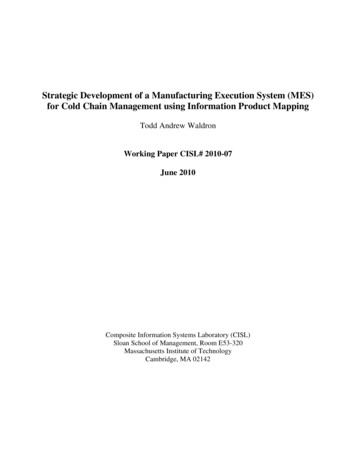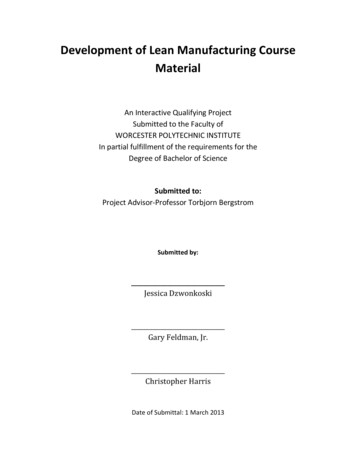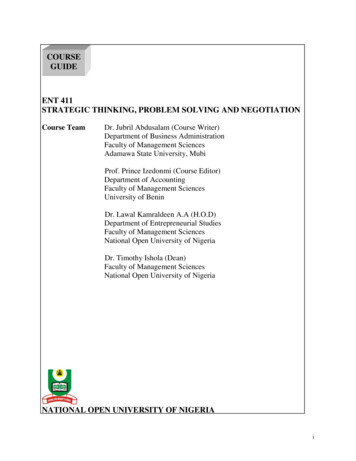
Transcription
Strategic Development of a Manufacturing Execution System (MES)for Cold Chain Management using Information Product MappingTodd Andrew WaldronWorking Paper CISL# 2010-07June 2010Composite Information Systems Laboratory (CISL)Sloan School of Management, Room E53-320Massachusetts Institute of TechnologyCambridge, MA 02142
Strategic Development of a Manufacturing ExecutionSystem (MES) for Cold Chain Managementusing Information Product MappingbyTodd Andrew WaldronB.S. Chemical Engineering, Drexel University, 2002M. Biotechnology, University of Pennsylvania, 2007Submitted to the MIT Sloan School of Management and the Engineering Systems Division in PartialFulfillment of the Requirements for the Degrees ofMaster of Business AdministrationANDMaster of Science in Chemical EngineeringIn conjunction with the Leaders for Global Operations Program at theMassachusetts Institute of TechnologyJune 2011 2011 Massachusetts Institute of Technology. All rights reserved.Signature of AuthorMay 6, 2011Chemical Engineering, MIT Sloan School of ManagementCertified byStuart Madnick, Thesis SupervisorJohn Norris Maguire Professor of Information Technology, MIT Sloan School of ManagementCertified byJ. Christopher Love, Thesis SupervisorTexaco-Mangelsdorf Career Development Professor of Chemical EngineeringAccepted byWilliam Deen, Chairman, Committee for Graduate StudentsDepartment of Chemical EngineeringAccepted byDebbie Berechman, Executive Director of MBA ProgramMIT Sloan School of Management
This page intentionally left blank.2
Strategic Development of a Manufacturing ExecutionSystem (MES) for Cold Chain Managementusing Information Product MappingbyTodd Andrew WaldronSubmitted to the MIT Sloan School of Management and the Department of Chemical Engineeringin Partial Fulfillment of the Requirements for the Degrees ofMaster of Business AdministrationANDMaster of Science in Chemical EngineeringABSTRACTThe Vaccines & Diagnostics (V&D) division of Novartis recently developed a global automationstrategy that highlights the need to implement manufacturing execution systems (MES). Benefits of MES(electronic production records) include enhancing the compliance position of the organization, reducingproduction delays, and improving process flexibility, however implementing MES at globalmanufacturing sites presents unique logistical challenges that need to be overcome.The goal of this thesis is to investigate cold chain management as an expanded functionality forMES. The thesis attempts to identify best practices for the strategic implementation of MES in themanagement of cold chain vaccine products. While the concepts shared in this thesis are in the context ofmanaging the cold chain for vaccine product, the best practices can be applied to a variety of cold chainmanagement scenarios.In order to generate best practice recommendations for the strategic implementation of a coldchain management MES, a thorough understanding of the manufacturing process will need to be acquired.The first tool used to gain this understanding was Value Stream Mapping (VSM). VSM provided someinsight into the current paper-based cold chain management system, however, the tool was not applicablefor understanding the flow of information generated within the cold chain management system.Another tool was used to enable the organization to focus on the data generated by a process, theInformation Product Map (IP-Map). Current-state IP-Maps of the Rosia, Italy, site cold chain weregenerated and numerous areas for improving the data quality were identified. Future-state IP-Maps of theRosia, Italy, site cold chain were generated to demonstrate how the implementation of a cold chain MEScould improve the shortcomings of the current system.The future-state IP maps were based on two major underlying assumptions that directly lead torecommendations for the cold chain MES implementation. The first recommendation is that a unit ofmeasurement smaller than lot size must be selected for tracking material data in the MES. The secondrecommendation is that data capture technology for material entering or leaving cold storage must beintegrated with the MES.Thesis Supervisor: Stuart MadnickJohn Norris Maguire Professor of Information Technology, MIT Sloan School of ManagementThesis Supervisor: J. Christopher LoveTexaco-Mangelsdorf Career Development Professor of Chemical Engineering3
This page intentionally left blank.4
ACKNOWLEDGMENTSAcknowledgments go here.5
This page intentionally left blank.6
TABLE OF CONTENTSABSTRACT . 3ACKNOWLEDGMENTS . 5TABLE OF CONTENTS . 7TABLE OF FIGURES . 9CHAPTER 1:INTRODUCTION AND THESIS OVERVIEW. 101.1Problem Description . 101.2Manufacturing Execution Systems . 101.3Project Drivers. 121.3.1 Enhance Compliance Position . 121.3.2 Reduce Production Delays . 131.3.3 Improve Process Flexibility . 131.4Hypothesis. 141.5Organization of Thesis . 141.6Confidentiality . 15CHAPTER 2:PROJECT CONTEXT . 162.1Company and Division Description . 162.2Manufacturing Cold Chain . 162.2.1 Stability . 162.2.2 Shelf-Life and Expiry . 172.2.3 Time Out-of-Refrigeration . 182.2.4 Cold Chain Management . 182.3Project Scope . 20CHAPTER 3:VALUE STREAM MAPPING (VSM) . 213.1VSM Description . 213.2Findings from VSM . 223.3VSM Shortcomings for Understanding the Cold Chain . 27CHAPTER 4:CURRENT-STATE INFORMATION PRODUCT MAPS (IP-MAPS) . 294.1IP-MAP Advantages for Understanding the Cold Chain . 294.2IP-Map Description . 294.3IP-Map Development Approach . 314.4Current-State IP-Maps. 324.4.1 Transfer of Bulk Material from the Global Warehouse to the Filling and Inspection LocalCold Room . 324.4.2 Filling and Inspection Processes. 334.4.3 Transfer of Filled/Inspected Product from the Filling and Inspection Local Cold Room tothe Packaging and Labeling Local Cold Room . 367
4.4.4 Packaging and Labeling Processes . 374.4.5 Transfer of Finished Product from the Packaging and Labeling Local Cold Room to theGlobal Warehouse . 414.4.6 Finished Product Time Out-of-Refrigeration Data Review . 424.5Cold Chain Management Concerns Identified by the IP-Maps . 43CHAPTER 5:5.1FUTURE-STATE INFORMATION PRODUCT MAPS (IP-MAPS) . 46Future-State IP-Maps . 465.1.1 Transfer of Bulk Material from the Global Warehouse to the Filling and Inspection LocalCold Room . 465.1.2 Filling and Inspection Processes. 475.1.3 Transfer of Filled/Inspected Product from the Filling and Inspection Local Cold Room tothe Packaging and Labeling Local Cold Room . 505.1.4 Packaging and Labeling Processes . 515.1.5 Transfer of Finished Product from the Packaging and Labeling Local Cold Room to theGlobal Warehouse . 545.1.6 Finished Product Time Out-of-Refrigeration Data Review . 555.2Cold Chain Management Improvements Found in the Future State IP-Maps . 57CHAPTER 6:RECOMMENDATIONS. 596.1Select a Smaller Unit of Measurement for theCold Chain MES . 596.2Ensure Cold Chain Data is Captured Automatically . 62BIBLIOGRAPHY . 648
TABLE OF FIGURESFigure 1: Manufacturing Operations Model . 11Figure 2: Vaccine Product Flow through Processing . 23Figure 3: Process Interruption Disrupts Material Flow. 24Figure 4: Division of Material during Processing . 25Figure 5: Processing of Material at Numerous Facilities . 26Figure 6: Straight Through Processing of Material. 27Figure 7: Information Product Map Symbol Guide . 30Figure 8: IP-Map for the Transfer of Bulk Material from the Global Warehouse . 32Figure 9: IP-Map for the Filling and Inspection Processes . 34Figure 10: IP-Map for the Transfer of Filled/Inspected Product from the Filling and Inspection Local ColdRoom to the Packaging and Labeling Local Cold Room . 36Figure 11: IP-Map for the Packaging and Labeling Processes . 38Figure 12: IP-Map for the Transfer of Finished Product from the Packaging and Labeling Local ColdRoom to the Global Warehouse . 41Figure 13: IP-Map for the Finished Product Time Out-of-Refrigeration Data Review . 43Figure 14: Future-State IP-Map for the Transfer of Bulk Material from the Global Warehouse to theFilling and Inspection Local Cold Room . 47Figure 15: Future-State IP-Map for the Filling and Inspection Processes . 48Figure 16: Future-State IP-Map for the Transfer of Filled/Inspected Product from the Filling andInspection Local Cold Room to the Packaging and Labeling Local Cold Room . 50Figure 17: Future-State IP-Map for the Packaging and Labeling Processes. 52Figure 18: Future-State IP-Map for the Transfer of Finished Product from the Packaging and LabelingLocal Cold Room to the Global Warehouse . 55Figure 19: Future-State IP-Map for the Finished Product Time Out-of-Refrigeration Data Review . 569
CHAPTER 1: INTRODUCTION AND THESIS OVERVIEW1.1 Problem DescriptionNovartis Vaccines & Diagnostics (V&D) division is currently characterized by a series ofmanual activities for capturing and reviewing process information. Manual data capture and review leadsto a low level of transparency, investigational capability, and process integration. In light of thesedeficiencies, the V&D division recently developed a new global automation strategy that highlights theimportance of Manufacturing Execution Systems (MES). MES have been identified as the main tool inthe business transformation road map that defines, documents, and controls all relevant production andquality parameters. Strategically implemented MES have the capability to generate a competitiveadvantage for the division through high levels of data transparency and flexible process integration.Vaccine products must be maintained within a cold chain throughout their lifecycle in themanufacturing facility. Maintaining vaccine products at proper refrigerated storage conditions in betweenprocessing steps is a critical component to ensuring the effectiveness of the product. Calculating the timeout-of-refrigeration for vaccine product is a manually intensive process performed across a number offunctional groups within the V&D division. Manual data capture leads to an increased cycle time andinefficient use of resources. MES are a tool that can automatically collect and analyze time out-ofrefrigeration data for vaccine product throughout the division, empowering key stakeholders to makedata-driven processing decisions.This thesis is based on work that was performed by the author over a six and a half month periodat the Rosia, Italy, site of Novartis V&D. The goal of this thesis is to investigate cold chain managementas an expanded functionality for MES. The thesis attempts to identify what the best practices are forstrategic implementation of MES in the management of cold chain vaccine products. While the conceptsshared in this thesis are in the context of managing the cold chain for vaccine product, the best practicescan be applied to a variety of cold chain management scenarios.1.2 Manufacturing Execution SystemsThe manufacturing operations model of the pharmaceutical industry can be described asoverlaying levels of management. Lower levels manage local events that have a discrete impact whilehigher levels direct global changes that have widespread implications. Information technology systems10
can be used to manage a layer of the model or to enhance communications between the layers of themodel.Level 0, the plant level, represents the actual production process. Level 1, the instrumentationlevel, represents the equipment that sense and manipulate the production process. Instruments in Level 1take measurements of the Level 0 production. Level 2, the control level, represents the automation thatcontrols the production process. Process control systems (PCS) that direct infrastructure based onreadings from Level 1 instruments are also called supervisory control and data acquisition (SCADA)systems. Information collected from the Level 1 instruments are often stored in data historians at Level 2.Level 3, the operations level, represents the production recipes and work flows that produce the desiredproducts. MES manage the manufacturing steps that are controlled by Level 2 automation. PCS controlall relevant process parameters whose validated ranges are defined by the MES. Level 4, the businessplanning level, manages the overall production plan and material flow. Enterprise resource planning(ERP) software collects data from accounting, sales, and planning to determine the work orders to meetdemand forecasts. MES schedule production process in an optimal way based on instructions from theLevel 4 production plans (Allan, 2009).Figure 1: Manufacturing Operations ModelLevel 4BusinessPlanningLevel 3OperationsLevel 2Control /Data HistorianLevel 1InstrumentationLevel 0ProductionMES are the electronic interface that links the personnel, instruments, equipment, and automationof the shop floor with the inventory, planning, logistics, and finance of management. MES build thisbridge by being the electronic interface that directs production and quality control systems (Blumenthal,2004). The most important feature of MES is their management of electronic batch records. Production11
batch records serve as the instructions for supervisors and process technicians. Production batch recordscontain all of the critical information about processing steps. Information about who executed the stepsand when the steps were executed are recorded in the production batch record. Production batch recordscan also include ranges for critical process parameters. Examples of critical process parameters includethe weight of material additions, the temperature of process tanks, and the pH of process fluids. Criticalprocess parameter data from instruments can be recorded in the process batch records and comparedagainst pre-defined ranges. Electronic batch records automatically associate captured process data withthe appropriate batch record.1.3 Project DriversStrategic implementation of MES to bridge the Operations and Control levels of themanufacturing operations hierarchy has regulatory and financial benefits. The business impact of thisimplementation includes an enhanced compliance position for the division, reductions in productiondelays, and improved process flexibility for enhanced use of organization resources.1.3.1Enhance Compliance PositionThe first main benefit of MES implementation is their ability to enhance the compliance positionof the organization. Maintaining positive relationships with worldwide regulatory agencies is importantwhen trying to resolve manufacturing issues that fall under their jurisdiction and when trying to promotenew technologies and products for your company portfolio. Processing data that is recorded frominstruments into documents by a technician has the opportunity to be compromised. In order to preventthe unintentional inclusion of incorrect data to a batch record, a check of the data entry by anothertechnician or supervisor is often incorporated into data capture procedures. Manual data capture removestechnicians and supervisors from critical processing functions that ensure the batch is being manufacturedaccording to the approved procedures. MES can automatically verify information captured by instrumentsand associate that data with the correct electronic batch record. The MES can also be programmed tocollect process data at specific time points during the process so the division is not dependent on manualdata entry, which could be impacted by the availability of labor.In addition to associating data with a specific batch record, the functionality of the MES can beused to compare the data to an expected result. If the process data is outside of a predefined range, theMES can flag the result internally or in conjunction with another system and send a notification to beginan investigation into the result. The data that is managed by the MES can be archived in a data historian.The functionality of the MES can interact with the data historian to aid investigations and process12
improvement projects. When paper-based batch records are in place, data mining for investigations is atime-consuming process. Questions that require data about previous lots of material require theinvestigator to go back to the source documents and have his data audited. MES systems that interfacewith a data historian allow data that has already been reviewed to be easily accessed and organized by theinvestigator. Additionally, this data can be used to map process trends, increasing visibility and allowingsupervisors and technicians to take preventative actions.1.3.2Reduce Production DelaysThe next main benefit of MES implementation is their ability to reduce production delays. Havingverified data automatically associated with electronic batch records not only enhances the complianceposition of the organization, but it can also decrease product release cycle time. Since all batch data isavailable as soon as manufacturing is complete, personnel in the quality and release departments haveimmediate access to batch information. Quality personnel are no longer responsible for a line-by-linereview of the paper batch records to ensure all of the data is accurate and has been verified. The MESelectronic batch record allows quality personnel to focus on critical process parameters, completing theirbatch record review to release the associated material to the market in a fraction of the time compared tothe paper-based system. Expedited review of the batch record can help material get to the market quicker,allowing the division to capitalize on a new market or preventing a possible stock-out situation for ahealth care critical product.1.3.3Improve Process FlexibilityThe last main benefit of MES implementation is their ability to improve the process flexibility ofthe organization. Processing material is comprised of similar steps such as measuring raw material,adding vaccine fluids to a tank for formulation, or packaging a vial. Each of these steps is comprised ofalmost identical instructions. The basic instructions can be programmed into MES and linked together toform basic operation blocks. MES store these basic operations blocks and allows the user to createelectronic batch records from these building blocks. The batch records designer saves a great deal of timeand effort because they do not have to develop a batch record from basic instructions each time a newproduct is added to the manufacturing site. Additionally, the operations blocks of the batch record can beuniversally modified if improvements to a manufacturing process are implemented.Having a standard interface for electronic batch records across the division improves productionintelligence across the organization. Resources can be shared across processes or across sites withoutadditional training on how to work with the batch record. Before MES, operations personnel that are13
assigned responsibilities in another department needed to learn the how the paper batch records wereorganized locally and how data was collected and entered into the batch record before they could begintraining on the local processing steps. Now that the interface is the same for all batch records, the operatoronly needs to be trained on the process steps before they can deliver value-added work to the area. MESallow for greater flexibility in assigning the work force which makes the division more adept at handlingunexpected product demand spikes.1.4 HypothesisMES are an established information technology tool for improving data transparency,investigational capability, and process integration. MES have the capability to manage productsmaintained within a cold chain if they are implemented appropriately. Best practices for strategicimplantation of cold chain management MES can be developed with the aid of process mappingtechniques.1.5 Organization of ThesisChapter 1 explains the problem and project motivation, defines manufacturing execution systems, andstates the hypothesis.Chapter 2 describes the company, division background, and project scope and defines cold chainmanagement.Chapter 3 defines value stream mapping, explains the benefits derived from initial use of this tool, anddiscusses the limitations of the tool when analyzing cold chain management information flow.Chapter 4 discusses why information product mapping is a valuable tool for analyzing cold chainmanagement information flow, defines information product mapping, and reviews maps for the currentstate cold chain management processes.Chapter 5 discusses the benefits of manufacturing execution systems for cold chain management andreviews maps of the future-state cold chain managed by manufacturing execution systems.Chapter 6 provides best practice recommendations for the cold chain management implementation.14
1.6 ConfidentialityProduction data and diagrams presented in this thesis have been distorted or are hypothetical forthe purpose of ensuring the confidentiality of information proprietary to Novartis.15
CHAPTER 2: PROJECT CONTEXT2.1 Company and Division DescriptionNovartis International AG is a multinational pharmaceutical company headquartered in Basel,Switzerland. Novartis was formed in 1996 by the merger of Ciba-Geigy and Sandoz Laboratories. Thecompany is divided into four international divisions: pharmaceuticals, vaccines and diagnostics, Sandoz(generic pharmaceuticals), and consumer health. The V&D division was added to the company in 2006after the acquisition of Chiron Corporation.The history of mergers and acquisitions that characterized the formation of Novartis has alsoshaped the current culture of the company. The divisions of the company act independently andinformation is not readily exchanged across divisional boundaries. Each division develops its ownstrategies and creates its own vision for future success. Communicating best practices across divisions isan important source of time and cost savings for Novartis. The V&D division is segmented in the samemanner as the parent company based on the acquisition of the Chiron Corporation. Creating one vision forthe division and finding common platforms to promote operational efficiencies are a key part of thedivision strategy.In 2010, Novartis had more than 50.6 billion in net sales. The V&D division accounted for 2.9billion in sales, or 6 percent of total net sales. V&D is the smallest of the four divisions by revenue,however, the division had a 25% increase in constant currency net sales from their total in 2009. Thedivision also has a strong pipeline that includes 15 vaccine candidates currently in clinical trials (Novartis,2010). The V&D division seeks to demonstrate that they are a critical piece of the Novartis portfolio. Thedivision has committed to have systems in place to support its strategic growth. This project will strive todevelop best practices for a cold chain management MES that will increase flexibility among theoperations sites and prepare the division to r
1.2 Manufacturing Execution Systems The manufacturing operations model of the pharmaceutical industry can be described as overlaying levels of management. Lower levels manage local events that have a discrete impact while higher levels direct global changes that have widespread implications. Information technology systems











